Intel’s Arrow Lake roadmap includes laptop gaming chips too --[Reported by Umva mag]
Intel’s “Arrow Lake” processor plans include both desktop and laptop chips, creating two new performance tiers atop its existing “Lunar Lake” laptop processors plus the Core Ultra 200S desktop processors it’s launching today. Intel disclosed plans for three different product families: the Arrow Lake-S desktop processor as well as the Arrow Lake-HX and Arrow Lake-H processors for laptops. While Intel will begin taking orders for the Core Ultra 200S (Arrow Lake-S) family beginning on October 24, Intel will ship its notebook processors in the first quarter of 2025. A year ago, Intel introduced its 14th-gen desktop processors at an October launch event, then followed with lower-power desktop offerings at CES 2024. All three Arrow Lake families strongly emphasize energy efficiency. On average, Arrow Lake will cut power by 30 percent compared to the previous generation while boosting multithreaded performance by about 10 percent compared to the 14th-generation parts, according to Josh Newman, general manager and vice president of product marketing and management for Intel’s Client Computing Group. And yes, Arrow Lake is Intel’s first desktop chip with an integrated NPU and AI. Arrow Lake also brings Intel’s tiled processor design to the desktop. Although it includes elements of both Core Ultra chips, Meteor Lake and Lunar Lake, its killer selling point will be its low power — real-world power consumption that could be up to half that of the earlier 14th-gen Core chip, Intel claims, with “parity” performance. In the real world, that may translate into gaming performance that’s slower than the 14th-gen Core. Still, Intel claims that Arrow Lake’s graphics performance essentially doubles from the prior generation. The Arrow Lake-S and -HX chips don’t emphasize integrated GPU performance as much. However, a recognition that they’ll be paired with discrete GPUs. Intel’s goals for Arrow Lake. Intel’s goals for Arrow Lake.Intel Intel’s goals for Arrow Lake.Intel Intel Intel’s rollout plan is different this time around. Normally, it explains the underlying architecture of the chip — which this story reports. Today, however, Intel is also disclosing the speeds, prices, and performance of the Core Ultra 200S (Arrow Lake) family, which we’ve covered separately. This might be more interesting to enthusiasts than just how Arrow Lake works, so check out that report, too! We explain in more detail why Intel chose an older, slower NPU for AI functions, and also why hyperthreading has been removed from Arrow Lake yet again. Arrow Lake: Lunar Lake’s CPU, repurposed for desktop PCs Architecturally, Intel executives consider the Arrow Lake-S desktop chip and the mobile Arrow Lake-HX for laptops essentially two versions of the same chip for the enthusiast PC segment — there are differences in the packaging, the power which they draw, and a few other software tweaks. Otherwise, they’re identical, Greg Boots, Arrow Lake’s product marketing manager, said. It’s worth noting that this is the first “disaggregated” CPU in Intel’s desktop lineup, breaking up the “chip” into tiles collected inside a single processor package. Arrow Lake consists of compute, GPU, SOC, and I/O tiles along with a “filler” and “base” tile for stability — all linked together using Intel’s Foveros technology inside a single package. Save for the base tile, all are manufactured at TSMC, like Lunar Lake: the compute (TSMC’s N3B), the GPU (TSMC’s N5P), and the I/O and SOC tiles (TSMC’s N6) are all connected to Intel’s 1227.1 base tile. The Core 200S family all uses 125W of power, consuming up to 250W while operating in turbo mode. This disaggregated , modular approach will be the way Intel designs chips going forward. This disaggregated , modular approach will be the way Intel designs chips going forward.Intel This disaggregated , modular approach will be the way Intel designs chips going forward.Intel Intel For now, the compute tile on both chips will include varying numbers of performance cores (known as Lion Cove), and efficiency cores (code-named Skymont). Intel has quietly begun prioritizing the E-cores, shunting tasks to them first. Skymont may be an “efficiency” core, but Intel more and more is assigning them mainstream tasks. Both the Lion Cove and Skymont cores are the same Lion Cove and Skymont cores that appeared in Lunar Lake, with an additional tweak. Each P-core now has 3MB of level-2 cache apiece rather than 2MB in the 14th-gen Core. Intel performed other internal tricks such as increasing the execution ports, but eliminated hyperthreading to save power and space. Like Lunar Lake, the Arrow Lake chip was designed to maximize single-threaded performance per watt and performance per area. Put another way, Intel is trying to keep the chip as small and as power-efficient as possible while maximizing sing
![Intel’s Arrow Lake roadmap includes laptop gaming chips too --[Reported by Umva mag]](https://umva.top/uploads/images/202410/image_870x_6707ecb51b224.jpg)
Intel’s “Arrow Lake” processor plans include both desktop and laptop chips, creating two new performance tiers atop its existing “Lunar Lake” laptop processors plus the Core Ultra 200S desktop processors it’s launching today.
Intel disclosed plans for three different product families: the Arrow Lake-S desktop processor as well as the Arrow Lake-HX and Arrow Lake-H processors for laptops. While Intel will begin taking orders for the Core Ultra 200S (Arrow Lake-S) family beginning on October 24, Intel will ship its notebook processors in the first quarter of 2025. A year ago, Intel introduced its 14th-gen desktop processors at an October launch event, then followed with lower-power desktop offerings at CES 2024.
All three Arrow Lake families strongly emphasize energy efficiency. On average, Arrow Lake will cut power by 30 percent compared to the previous generation while boosting multithreaded performance by about 10 percent compared to the 14th-generation parts, according to Josh Newman, general manager and vice president of product marketing and management for Intel’s Client Computing Group. And yes, Arrow Lake is Intel’s first desktop chip with an integrated NPU and AI.
Arrow Lake also brings Intel’s tiled processor design to the desktop. Although it includes elements of both Core Ultra chips, Meteor Lake and Lunar Lake, its killer selling point will be its low power — real-world power consumption that could be up to half that of the earlier 14th-gen Core chip, Intel claims, with “parity” performance.
In the real world, that may translate into gaming performance that’s slower than the 14th-gen Core. Still, Intel claims that Arrow Lake’s graphics performance essentially doubles from the prior generation. The Arrow Lake-S and -HX chips don’t emphasize integrated GPU performance as much. However, a recognition that they’ll be paired with discrete GPUs.
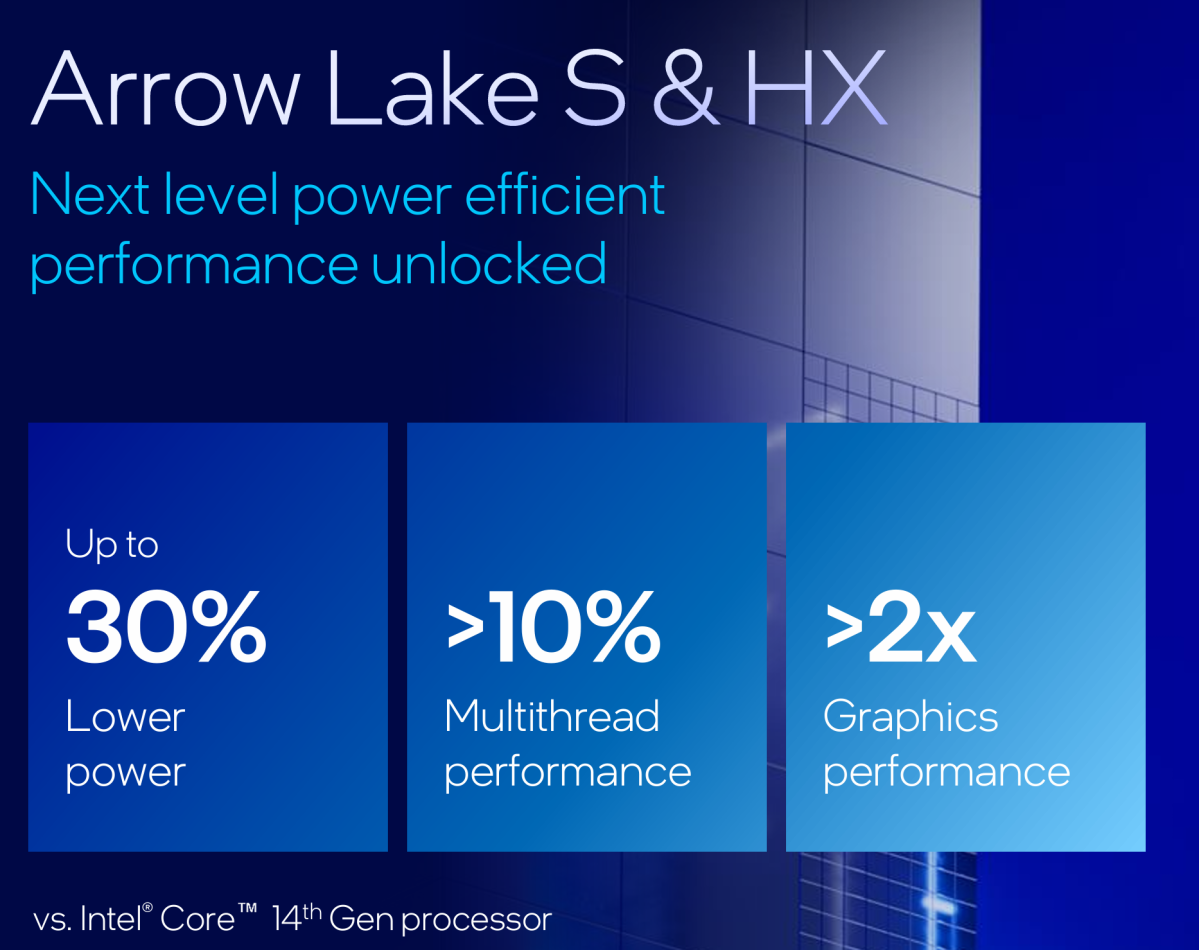
Intel
Intel’s rollout plan is different this time around. Normally, it explains the underlying architecture of the chip — which this story reports. Today, however, Intel is also disclosing the speeds, prices, and performance of the Core Ultra 200S (Arrow Lake) family, which we’ve covered separately.
This might be more interesting to enthusiasts than just how Arrow Lake works, so check out that report, too! We explain in more detail why Intel chose an older, slower NPU for AI functions, and also why hyperthreading has been removed from Arrow Lake yet again.
Arrow Lake: Lunar Lake’s CPU, repurposed for desktop PCs
Architecturally, Intel executives consider the Arrow Lake-S desktop chip and the mobile Arrow Lake-HX for laptops essentially two versions of the same chip for the enthusiast PC segment — there are differences in the packaging, the power which they draw, and a few other software tweaks. Otherwise, they’re identical, Greg Boots, Arrow Lake’s product marketing manager, said. It’s worth noting that this is the first “disaggregated” CPU in Intel’s desktop lineup, breaking up the “chip” into tiles collected inside a single processor package.
Arrow Lake consists of compute, GPU, SOC, and I/O tiles along with a “filler” and “base” tile for stability — all linked together using Intel’s Foveros technology inside a single package. Save for the base tile, all are manufactured at TSMC, like Lunar Lake: the compute (TSMC’s N3B), the GPU (TSMC’s N5P), and the I/O and SOC tiles (TSMC’s N6) are all connected to Intel’s 1227.1 base tile. The Core 200S family all uses 125W of power, consuming up to 250W while operating in turbo mode.
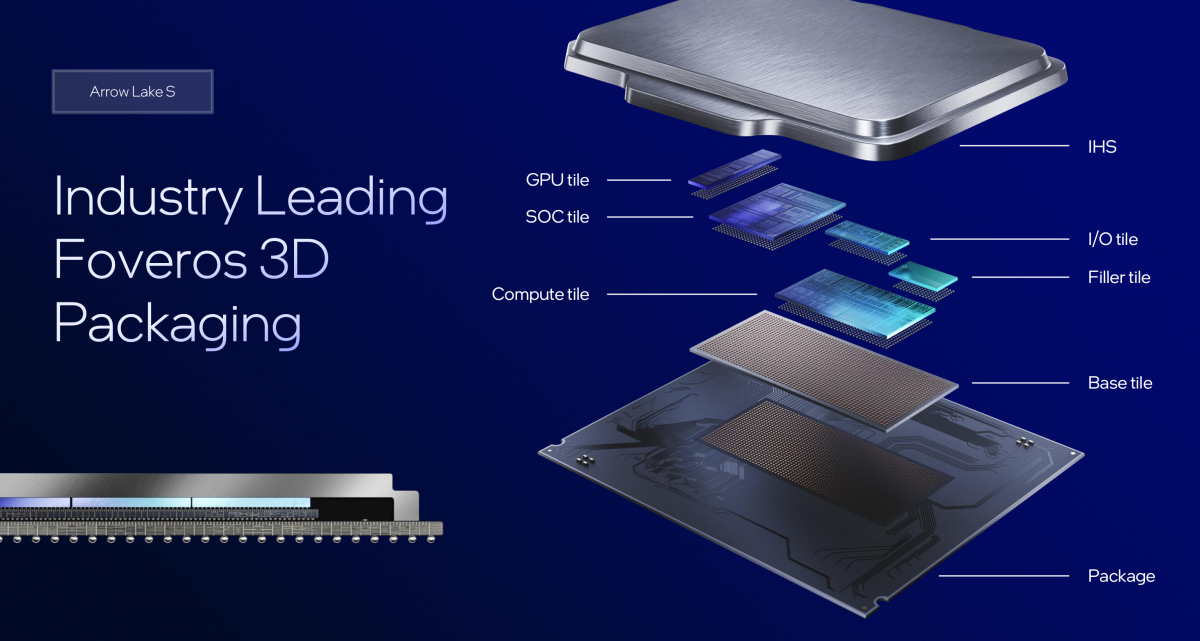
Intel
For now, the compute tile on both chips will include varying numbers of performance cores (known as Lion Cove), and efficiency cores (code-named Skymont). Intel has quietly begun prioritizing the E-cores, shunting tasks to them first. Skymont may be an “efficiency” core, but Intel more and more is assigning them mainstream tasks.
Both the Lion Cove and Skymont cores are the same Lion Cove and Skymont cores that appeared in Lunar Lake, with an additional tweak. Each P-core now has 3MB of level-2 cache apiece rather than 2MB in the 14th-gen Core. Intel performed other internal tricks such as increasing the execution ports, but eliminated hyperthreading to save power and space.
Like Lunar Lake, the Arrow Lake chip was designed to maximize single-threaded performance per watt and performance per area. Put another way, Intel is trying to keep the chip as small and as power-efficient as possible while maximizing single-threaded performance. Turning on just a single thread minimizes power and single-threaded performance is also one of the tricks Apple’s M-series chips use to make the Mac OS operating system feel snappy. To help, Intel uses an “AI” power management system to balance power and performance. But the multiple P- and E-cores have been designed with games in mind, Boots said.
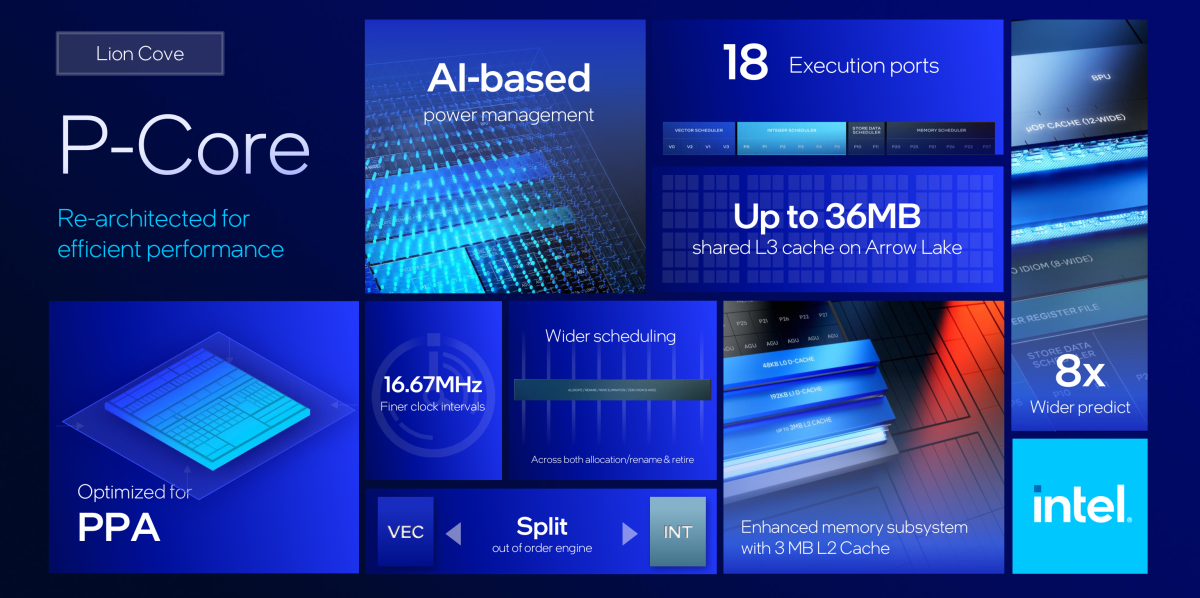
Intel
Arrow Lake should perform about nine percent faster at the same clock speed than the 14th-gen Core chip, Boots said. (This is otherwise known as a 9 percent IPC improvement or instructions-per-clock, representing the improvement from just the design alone).
Within the Skymont E-cores, there are more under-the-hood improvements, from a deepened instruction queue to a reduction in latency. Intel also added additional execution units to improve AI performance, twice what it was before in its 14th-gen Core chips.
Intel estimates that, measured by the spec_rate2017 benchmark, that the single-threaded integer performance in the Skymont (Arrow Lake) E-cores increased by 32 percent versus Gracemont (the 14th-gen P-Cores), while the single-threaded floating-point performance improvement topped 72 percent. Multi-threaded integer performance is 32 percent faster than Gracemont, while multi-threaded performance is 55 percent faster.
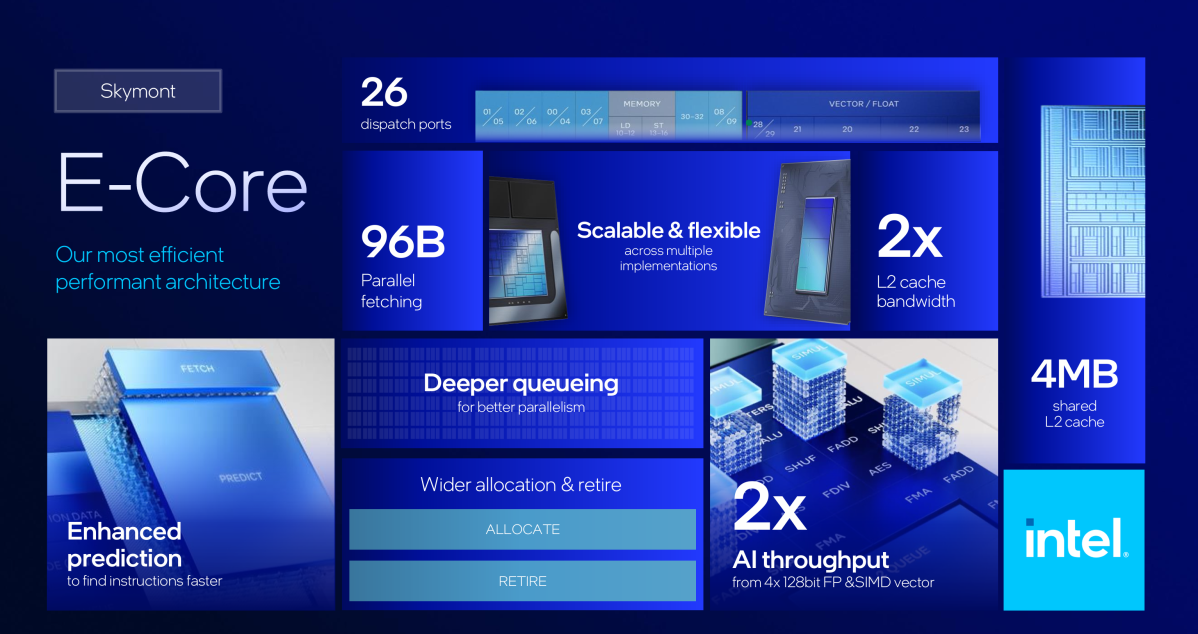
Intel
Intel’s Thread Director has also improved. Like Lunar Lake, tasks are routed to the E-cores first, then the P-cores. That prioritizes lower power consumption. Intel claims that how it does this, however, is smarter than how the prior 14th-gen Core chips handled things, with better hardware-based prediction to route tasks to the appropriate E-cores, and then if necessary, to an available P-Core. Intel also improved its prediction model so it can improve the scheduling of these tasks as new workloads drop into the Arrow Lake’s instruction queue.
“That means that it’s able to hold certain tasks to certain cores that are better at any given task,” Boots said.
You still can’t manually route specific threads to specific cores. On the other hand, Intel is quietly pushing technologies like Intel Application Optimization, which “recognizes” a game and immediately pushes the PC to its performance cores first. (Many of the game benchmarks featured in our accompanying real-world Arrow Lake performance preview turn this feature on).
Arrow Lake still supports Modern Standby, which allows the laptop to perform some background tasks while in a low-power state. That’s not necessarily a good thing, according to Arm proponents — X86 CPUs sometimes have issues performing those tasks and resuming their sleep state. Still, Intel believes these other power-saving aspects will overcome this.
“When we couple the massive power improvement with the changes we’re making on Thread Director and with the improved memory bandwidth and with an efficient GPU and NPU…you get an incredible benefit for users,” Boots said.
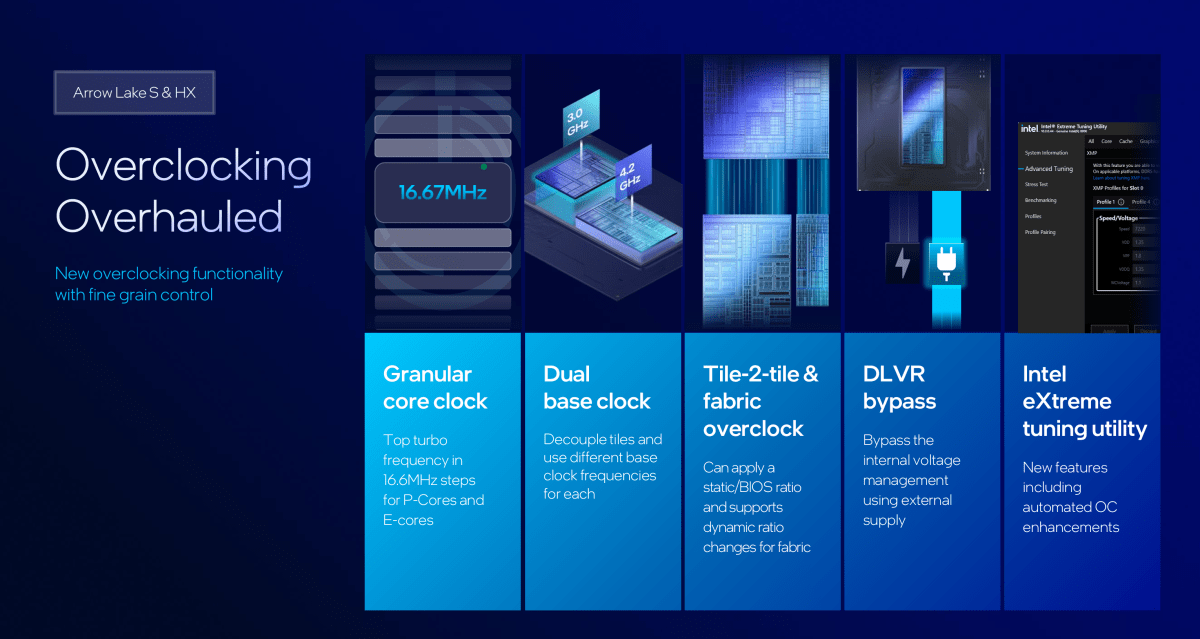
Intel
Overclockers that want to toss aside Intel’s power savings and push the processor to its limits have additional options, too. The simplest way will be to use Intel’s Extreme Tuning Utility (XTU), which will use AI to enable a one-click overclock of the user’s system. But there are other tweaks for overclockers: Intel’s clock speeds can be incremented in as little as 16.67MHz now, allowing overclockers to eke out the tiniest steps of additional performance. And the tiles won’t all run at the same speed either.
All of the different tiles in the chip can now be independently clocked and controlled. Even the speed in which the tiles communicate with one another can be manipulated, Boots said.
Intel’s desktop PC processors move into the Xe generation
Intel’s Core i9-14900HX chips, also known as Raptor Lake Refresh, continued the legacy of Intel’s 13th-gen Core chips. That meant, in terms of graphics, that they still used Intel’s legacy Execution Unit as the fundamental building block of its iGPU performance. (The 14900HX had 32 EUs with a maximum clock frequency of 1.65GHz). With Lunar Lake and now Arrow Lake, the Xe core is now ascendant, but it’s the first-generation Xe GPU that appeared in Meteor Lake.

Intel
Still, Lunar Lake offers a more powerful integrated iGPU than the new Arrow Lake chip does. Lunar Lake included eight Xe cores, 64 vector engines, four ray-tracing units, and two geometry pipelines, along with 8MB of level-2 cache. Arrow Lake-S and the Arrow Lake-HX chip trim that to four Xe cores, 64 vector engines, one geometry pipeline, four ray-tracing units, and 4MB of level-2 cache. Still, that’s more than twice the performance of the GPU inside the 14th-gen Core chip, Boots said. Arrow Lake also runs at a faster graphical clock speed. XeSS, Intel’s game-frames technology, is also present.
This is also where Intel’s second mobile chip, Arrow Lake-H, differs. Intel isn’t saying a lot about Arrow Lake-H, but it has a robust graphics engine, even if it is still a first-generation Xe core. It has eight Xe cores, 128 vector engines (the most on an Intel integrated GPU so far), 128 XMX engines, two geometry pipelines, eight ray tracing units, and 8 MB of L2 cache. XMX are Intel’s Xe Matrix Extensions, essentially allowing the GPU to process certain AI instructions.
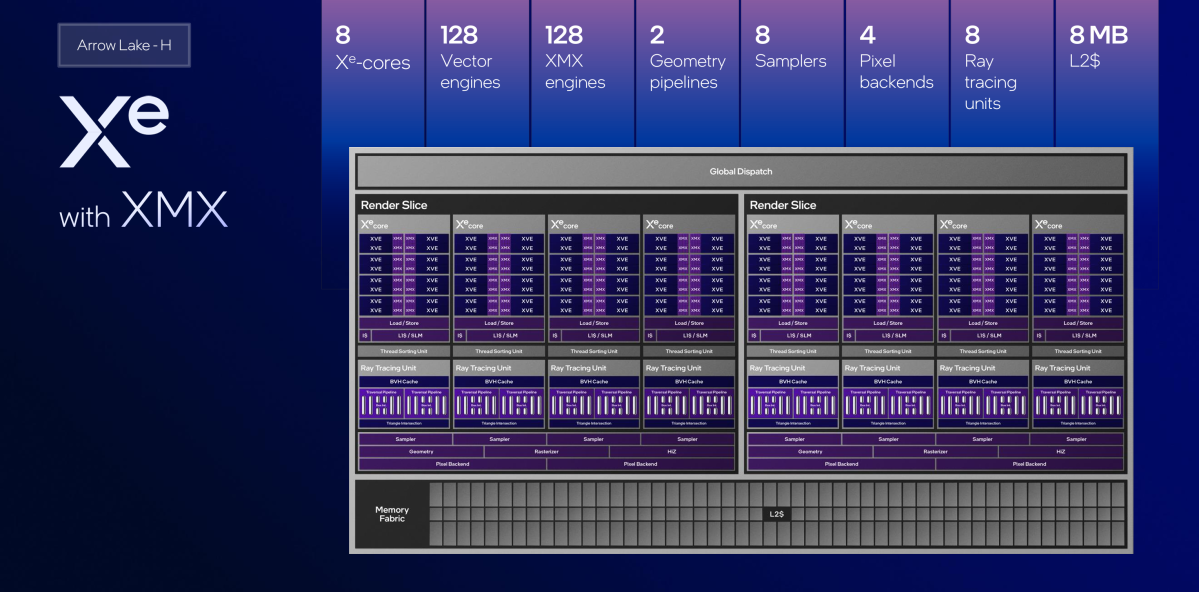
Intel
Arrow Lake shares a common display engine across the Arrow Lake-S, -HX and -H chips. The engine can output up to a single display in either 1080p or 1440p at 360Hz resolution, or to four 4K60 displays or to a single 8K60 display. Both HDMI 2.1 and DisplayPort 2.1 are supported, as well as embedded DisplayPort (eDP) 1.4. The complementary codec engine can decode up to 8K60 in 10-bit HDR, and encode 8K120 video also at 10-bit HDR. The VP9, AVC, HEVC, and the new AV1 codec are supported for both encoding and decoding.
Checking the box for AI
Again, none of these new chips, mobile or desktop, pass the TOPS threshold to qualify as Copilot+ AI-powered PCs. As far as AI is concerned, Arrow Lake-S and Arrow Lake-HX contain just the “NPU 3” architecture of Meteor Lake, with 13 TOPS behind it. To that, Intel adds 15 TOPS of CPU power and eight TOPS of GPU power, for 36 TOPS in all. (Intel measures TOPS, trillions of operations per second, using 8-bit integer or INT8 calculations). Some AI accelerators such as MemryX use trillions of more complex floating-point operations instead.
Arrow Lake-H, the other mobile chip, includes the more powerful GPU engine, also provides 13 TOPS with its own integrated NPU 3 engine. However, its GPU provides 77 TOPS, plus 9 TOPS from the CPU. All told, that’s 99 TOPS in total.

Intel
Intel’s new 800-series chipset for Arrow Lake
Arrow Lake will be accompanied by a new Intel 800-series chipset, which supports both PCI Express 5.0 as well as a pair of Thunderbolt 4 ports for external I/O.
Arrow Lake notebooks and desktops alike will be able to use DDR5-6400 memory — though there doesn’t seem to be support for the lower-power LPDDR5X memory that Lunar Lake used. The chipset will support up to 48GB per DIMM and 192GB total, with optional ECC support. There’s no on-package memory, either, unlike Lunar Lake.
You won’t find the latest connectivity standards, however, and there’s a reason for that. Inside the Intel 800 chipset are 48 PCIe lanes (with 24 PCIe 4 lanes off the processor), Wi-Fi 6E, and Bluetooth 5.3. There are also 32 USB 3.2 lanes, including five dedicated lanes for a 20Gbps connection to an external SSD.

Intel
Both Boots and Newman said that Intel’s PC customers typically differentiate themselves with discrete components that can be added on to the base platform — so, if a customer wanted to, they could buy Intel’s discrete Thunderbolt 5 component, for example, or a Wi-Fi 7 radio. The upcoming Arrow Lake-H mobile platform, however, will include some of the additional connectivity features, integrated in: Wi-Fi 7 and Bluetooth 5.4. Otherwise, everything else is the same. Of course, Intel’s Killer networking software works with Arrow Lake, and can help prioritize network connections.
Finally, there’s security. Arrow Lake -S and -HX are secured-core PCs, providing some internal virtualization techniques to help secure the PC. They’ve also added linear address space separation and Intel’s Silicon Security Engine for additional security.
That’s what makes Arrow Lake tick, at least from an architectural standpoint. I’d recommend that you next turn to the real-world performance of the Arrow Lake / Core Ultra 200S chip itself, and learn how it actually performs in the real world!
The following news has been carefully analyzed, curated, and compiled by Umva Mag from a diverse range of people, sources, and reputable platforms. Our editorial team strives to ensure the accuracy and reliability of the information we provide. By combining insights from multiple perspectives, we aim to offer a well-rounded and comprehensive understanding of the events and stories that shape our world. Umva Mag values transparency, accountability, and journalistic integrity, ensuring that each piece of content is delivered with the utmost professionalism.
![Bodies from Hurricane Helene devastation identified with FBI technology built to track criminals --[Reported by Umva mag]](https://umva.top/uploads/images/202410/image_430x256_67080b2a03dce.jpg)
![Death row inmate told to decide how he wants to be executed --[Reported by Umva mag]](https://umva.top/uploads/images/202410/image_430x256_670806c369e19.jpg)
![Severe delays on major Tube line because of faulty signalling --[Reported by Umva mag]](https://umva.top/uploads/images/202410/image_430x256_670806be7ac39.jpg)
![Egypt-Eritrea-Somalia tripartite alliance sealed at summit? --[Reported by Umva mag]](https://umva.top/uploads/images/202410/image_430x256_670804a2d61a4.jpg)
![Ethel Kennedy, social activist and widow of Robert F. Kennedy, dies at 96 --[Reported by Umva mag]](https://umva.top/uploads/images/202410/image_430x256_670801c88ca75.jpg)
![Blinken builds ties with Thailand, Malaysia after turbulence --[Reported by Umva mag]](https://umva.top/uploads/images/202410/image_430x256_670801c7de0b7.jpg)
![El Salvador named one of the world’s safest countries in 2023: At what cost? --[Reported by Umva mag]](https://umva.top/uploads/images/202410/image_430x256_67078bfc46260.jpg)
![AMLO criticized by protesters in Ayotzinapa case days before leaving office --[Reported by Umva mag]](https://umva.top/uploads/images/202410/image_430x256_67074f5f77603.jpg)
![Mexico’s President Andrés Manuel López Obrador bids farewell, signs laws aimed at cementing his legacy --[Reported by Umva mag]](https://umva.top/uploads/images/202410/image_430x256_67074f5bc385a.jpg)
![Off the back of Snowflake announcement, Google to invest $850 million in Latin America to build infrastructure for AI and cloud computing --[Reported by Umva mag]](https://umva.top/uploads/images/202410/image_430x256_67074f58721ba.jpg)
![Former police officer tried killing ex and her mum by driving car into funeral home --[Reported by Umva mag]](https://umva.top/uploads/images/202410/image_430x256_6707fc29961b7.jpg)
![European Commission: countries discover subsidies from the corona recovery fund --[Reported by Umva mag]](https://umva.top/uploads/images/202410/image_430x256_6707f9d526c25.jpg)
![Youth4Regions meets European Newsroom: Future journalists explore the heart of EU news reporting --[Reported by Umva mag]](https://umva.top/uploads/images/202410/image_430x256_6707f9d33cfba.jpg)
![49 Russians Targeted in Soviet-Style Punitive Psychiatry – Memorial --[Reported by Umva mag]](https://umva.top/uploads/images/202410/image_430x256_6707fbb1679a3.jpg)
![King of the Netherlands Visits The Moscow Times, TV Rain Newsrooms --[Reported by Umva mag]](https://umva.top/uploads/images/202410/image_430x256_6707fbb07fc3a.jpg)
![Chechen leader threatens MPs with ‘blood feud’ --[Reported by Umva mag]](https://umva.top/uploads/images/202410/image_430x256_6707f8b586190.jpg)
![Kremlin comments on reports that Ukraine is ready for ceasefire --[Reported by Umva mag]](https://umva.top/uploads/images/202410/image_430x256_6707f8b380152.jpg)
![Ghana: Paramount Chief lauds govt’s Agenda 111 initiative --[Reported by Umva mag]](https://umva.top/uploads/images/202410/image_430x256_6707fa23e4b7e.jpg)
![Promising progress on eye health in African region, but challenges remain --[Reported by Umva mag]](https://umva.top/uploads/images/202410/image_430x256_6707fa229823f.jpg)
![Morocco: EIB and ONCF partner for climate-resilient railway network --[Reported by Umva mag]](https://umva.top/uploads/images/202410/image_430x256_6707fa21096a3.jpg)
![Harris' struggles with Michigan's working class voters provides opening for Trump, GOP --[Reported by Umva mag]](https://umva.top/uploads/images/202410/image_430x256_67080aae915ea.jpg)
![BREAKING: Inflation Rises in September – Food Prices Surge – Auto Insurance Price Soar --[Reported by Umva mag]](https://umva.top/uploads/images/202410/image_430x256_670803abd9262.jpg)
![West Virginia Lawmakers Propose Legislation to Prevent State from Recognizing Winner in US Election If GOP Candidate is Assassinated, Seriously Injured in Assassination Attempt, Jailed, or Barred from the Ballot --[Reported by Umva mag]](https://umva.top/uploads/images/202410/image_430x256_670803aa2f493.jpg)
![‘Enough Is Enough’: Perpetually Harassed Colorado Baker Gets Good News from Supreme Court --[Reported by Umva mag]](https://umva.top/uploads/images/202410/image_430x256_670803a9504d9.jpg)
![Russia Announces They Have Evidence US and UK Were Behind Nord Stream Pipeline Bombings --[Reported by Umva mag]](https://umva.top/uploads/images/202410/image_430x256_670803a852680.jpg)
![Urgent call to shut down ‘rogue BBL clinics’ after mum, 33, becomes first in UK to die from dodgy op --[Reported by Umva mag]](https://umva.top/uploads/images/202410/image_430x256_6707f5d4ce049.jpg)
![‘We’re hurtling towards another winter crisis,’ experts warn as NHS figures show A&E is busier than ever --[Reported by Umva mag]](https://umva.top/uploads/images/202410/image_430x256_6707f5d2eb75c.jpg)
![5 Best High Intensity Workouts to Melt Visceral Fat --[Reported by Umva mag]](https://umva.top/uploads/images/202410/image_430x256_6707f035e32a5.jpg)
![Reducing RSV risk in older adults --[Reported by Umva mag]](https://umva.top/uploads/images/202410/image_430x256_6707e5a6429e8.jpg)
![Mum-of-two, 32, with ‘vampire disease’ vomits 30 times a day and lives in fear of dropping dead at dinner --[Reported by Umva mag]](https://umva.top/uploads/images/202410/image_430x256_6707e1ad20cdf.jpg)
![Tom Brady donates $100,000 toward hurricane relief in Florida --[Reported by Umva mag]](https://umva.top/uploads/images/202410/image_430x256_67080aebf29e1.jpg)
![Why are England and Greece wearing black armbands at Wembley tonight? --[Reported by Umva mag]](https://umva.top/uploads/images/202410/image_430x256_670806f64f59e.jpg)
![Jurgen Klopp’s new job, William Saliba transfer latest – exclusive Fabrizio Romano column --[Reported by Umva mag]](https://umva.top/uploads/images/202410/image_430x256_6708014ed9b9a.jpg)
![Dodgers' Shohei Ohtani has surprising emotional outburst after bizarre play --[Reported by Umva mag]](https://umva.top/uploads/images/202410/image_430x256_6708005f7ffc3.jpg)
![Wimbledon to replace human judges with electric line-calling in 2025 --[Reported by Umva mag]](https://umva.top/uploads/images/202410/image_430x256_6708005de02d5.jpg)
![Dua Lipa viral Diet Coke cocktail recipe: What we know about the reactions to Cola pickle juice and jalapeno concoction --[Reported by Umva mag]](https://umva.top/uploads/images/202410/image_430x256_67080a847013c.jpg)
![vivo V40 review --[Reported by Umva mag]](https://umva.top/uploads/images/202410/image_430x256_670804d3e9142.jpg)
![17 of My Favorite Sales From October Prime Day Are Still Active --[Reported by Umva mag]](https://umva.top/uploads/images/202410/image_430x256_6708018ce16da.jpg)
![My Favorite Inexpensive Light Fixtures for Every Part of the Home --[Reported by Umva mag]](https://umva.top/uploads/images/202410/image_430x256_6708018c316a1.jpg)
![The Best Apple Fritters Are Made With Instant Pancake Mix --[Reported by Umva mag]](https://umva.top/uploads/images/202410/image_430x256_6708018b8faab.jpg)
![Miranda Hart’s mystery husband makes unexpected appearance in new video as she thanks fans for support --[Reported by Umva mag]](https://umva.top/uploads/images/202410/image_430x256_67080a3a1d47d.jpg)
![‘So gross’ rant horrified MAFS UK fans as second secret sex session is revealed – saying ‘I feel sick on so many levels’ --[Reported by Umva mag]](https://umva.top/uploads/images/202410/image_430x256_67080a083bfbc.jpg)
![Alaska Airlines cuts one of its newest routes from Everett’s Paine Field --[Reported by Umva mag]](https://umva.top/uploads/images/202410/image_430x256_67080856def5d.jpg)
![Coca-Cola just brought back the ‘best’ flavour fans have been waiting 4 years for --[Reported by Umva mag]](https://umva.top/uploads/images/202410/image_430x256_670807311a547.jpg)
![Lucy Beaumont returns to TV for first time since Jon Richardson marriage split --[Reported by Umva mag]](https://umva.top/uploads/images/202410/image_430x256_6707ff7984b08.jpg)
![Mafs star Charlie holds hands with new girlfriend as she moves on after storming off show and split from Eve --[Reported by Umva mag]](https://umva.top/uploads/images/202410/image_430x256_6707ff7815ae5.jpg)
![I thought I was going to die days after my baby was born reveals BBC Breakfast star --[Reported by Umva mag]](https://umva.top/uploads/images/202410/image_430x256_6707ff75735c9.jpg)
![Liam Gallagher issues first update on Oasis reunion tour – and it’s GOOD news for fans who landed tickets --[Reported by Umva mag]](https://umva.top/uploads/images/202410/image_430x256_6707ffb8d8dbc.jpg)
![Bikini-clad Katie Price is rushed to medics in a wheelchair by boyfriend JJ Slater after injury on holiday --[Reported by Umva mag]](https://umva.top/uploads/images/202410/image_430x256_6707ffb4c9d14.jpg)
![Horrifying moment Sam Fox, 58, slams to the ground in nasty fall on stage – as fans accuse her of being ‘drunk’ --[Reported by Umva mag]](https://umva.top/uploads/images/202410/image_430x256_6707f59a33799.jpg)
![Spanish city dubbed the ‘garden of Europe’ has 24C autumns and nearby beautiful beaches --[Reported by Umva mag]](https://umva.top/uploads/images/202410/image_430x256_6707ffc6edbf9.jpg)
![Stretch of English coast where dinosaurs roamed – with some of the world’s best fossil hunting & Portuguese-like beaches --[Reported by Umva mag]](https://umva.top/uploads/images/202410/image_430x256_6707ffc4d4549.jpg)
![Where traditional Japanese ryokan culture meets unbeatable luxury: A review of Four Seasons Hotel Osaka --[Reported by Umva mag]](https://umva.top/uploads/images/202410/image_430x256_6707fdcc21a29.jpg)
![Users say this haircare duo is the ‘best on the market’ for silky, hydrated locks --[Reported by Umva mag]](https://umva.top/uploads/images/202410/image_430x256_6707fca783dd9.jpg)
![This supermarket is offering unlimited hot drinks all day every day from £1.85 --[Reported by Umva mag]](https://umva.top/uploads/images/202410/image_430x256_6707fca71a7af.jpg)
![My sister’s suffering with depression – how do I help? --[Reported by Umva mag]](https://umva.top/uploads/images/202410/image_430x256_6707e807de93e.jpg)
![Three tips cheap and fun tips for hosting an autumn games night --[Reported by Umva mag]](https://umva.top/uploads/images/202410/image_430x256_67080a412b404.jpg)
![How PSEi member stocks performed — October 10, 2024 --[Reported by Umva mag]](https://umva.top/uploads/images/202410/image_430x256_6708060e77ec2.jpg)
![DoE: Green energy auction finished within the year --[Reported by Umva mag]](https://umva.top/uploads/images/202410/image_430x256_6708060e3ec92.jpg)
![One-China Principle brooks no challenge and distortion --[Reported by Umva mag]](https://umva.top/uploads/images/202410/image_430x256_6708060de84b4.jpg)
![Net Foreign Direct Investment --[Reported by Umva mag]](https://umva.top/uploads/images/202410/image_430x256_6708060da8ea6.jpg)
![It will be awhile before OpenAI turns a profit. In the meantime, Microsoft gets a cut of revenue. --[Reported by Umva mag]](https://umva.top/uploads/images/202410/image_430x256_6707f78e51730.jpg)
![Advertisers share what's working in AI and what's not as the hype cycle fades --[Reported by Umva mag]](https://umva.top/uploads/images/202410/image_430x256_6707f78d7f8e9.jpg)
![Elvis Presley's daughter Lisa Marie's posthumous memoir was just published. Meet the King of Rock 'n' Roll's extended family. --[Reported by Umva mag]](https://umva.top/uploads/images/202410/image_430x256_6707f78cd1f0b.jpg)
![Russia's ruble hits the lowest level in a year against the dollar and the yuan --[Reported by Umva mag]](https://umva.top/uploads/images/202410/image_430x256_6707f78c565c7.jpg)
![Ukraine hit 2 Russian ammunition depots in 2 days — hammering the latest in a deep strike on a military airfield --[Reported by Umva mag]](https://umva.top/uploads/images/202410/image_430x256_6707f78be1e01.jpg)
![Chinese astronauts zoom in on their nation's launch sites from orbit (video) --[Reported by Umva mag]](https://umva.top/uploads/images/202410/image_430x256_67080988a7e95.jpg)
![Toothbrushes and showerheads are teeming with viruses unknown to science, study shows --[Reported by Umva mag]](https://umva.top/uploads/images/202410/image_430x256_6707ff039ec56.jpg)
![Google's Sycamore quantum computer chip can now outperform the fastest supercomputers, new study suggests --[Reported by Umva mag]](https://umva.top/uploads/images/202410/image_430x256_6707fefb33594.jpg)
![Post-Prime Day telescope deal: 34% off the Celestron NexStar 4SE --[Reported by Umva mag]](https://umva.top/uploads/images/202410/image_430x256_6707fefa1f4c8.jpg)
![Watch atoms fuse into world's 'smallest bubble' of water in 1st-of-its-kind 'nanoscale' video --[Reported by Umva mag]](https://umva.top/uploads/images/202410/image_430x256_6707f4e5e0f06.jpg)



![iPhone's satellite messaging: A lifeline in Hurricane Helene's aftermath --[Reported by Umva mag]](https://umva.top/uploads/images/202410/image_430x256_67074b4b5ee8a.jpg)
![Tecno Camon 30S arrives with Helio G100, curved 6.78" display and a 50MP Sony IMX896 camera --[Reported by Umva mag]](https://umva.top/uploads/images/202410/image_430x256_6707e5a922649.jpg)
![Can you still see the Draconid meteor shower tonight? --[Reported by Umva mag]](https://umva.top/uploads/images/202410/image_430x256_67064ff6510b6.jpg)
![Yes, COVID-19 mRNA vaccines can in fact alter the human genome. --[Reported by Umva mag]](https://umva.top/uploads/images/202410/image_140x98_670750a58e638.jpg)
![American Express pledges £100,000 in grants to support small businesses through champion small initiative --[Reported by Umva mag]](https://umva.top/uploads/images/202410/image_140x98_6707516418fc6.jpg)
![Watch: ‘Breaking the Silence Is a Step’ — Beyond the Lens of ‘Silence in Sikeston’ --[Reported by Umva mag]](https://umva.top/uploads/images/202410/image_140x98_6707a049a6966.jpg)
![Happening in Springfield: New Immigrants Offer Economic Promise, Health System Challenges --[Reported by Umva mag]](https://umva.top/uploads/images/202410/image_140x98_6707a04b368f0.jpg)
![Bahrain vs Indonesia | 2024-10-10 | 16:00 | Asia - World Cup Qualification --[Reported by Umva mag]](https://tv.umva.us/upload/TV/nda.jpg)